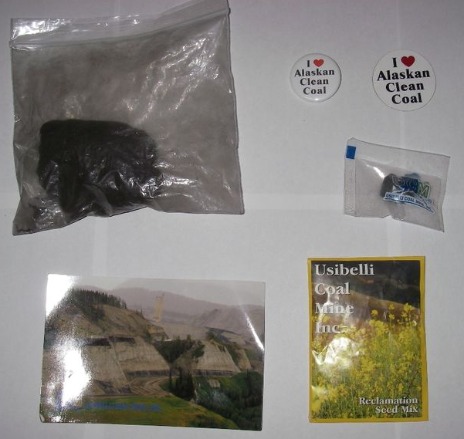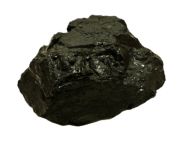 The coal gift bag. Photo: Russ MaddoxThis week, we got an email from Seward, Alaska, where our friend Russ Maddox was shocked at what his 9-year-old granddaughter brought home from a field trip last week to Aurora Energy Service’s Seward coal loading facility:
The coal gift bag. Photo: Russ MaddoxThis week, we got an email from Seward, Alaska, where our friend Russ Maddox was shocked at what his 9-year-old granddaughter brought home from a field trip last week to Aurora Energy Service’s Seward coal loading facility:
The gift bag included cellophane wrapped coal candy, a real lump of coal in a sandwich bag, and pins and refrigerator magnets emblazoned with ‘I Love Alaskan Clean Coal’ … Just what was my nine-year-old asthmatic grand-daughter supposed to do with a lump of coal? Deceitful messaging aside, whose idea was it to send a hazardous material home with schoolchildren? In food packaging in the same bag with similar looking candy in similar looking wrapping no less?
The coal gift bag was also documented on the Seward City News website.
I’ve lived most of my life in Appalachia, where the coal industry regularly gives kids goodies like coloring books and provides teachers with free lesson plans, all touting the glories of coal. They tend to gloss over the life-threatening pollution coal leaves in its wake. And now, to make matters worse, the industry is actually trying to roll back our nation’s clean air and clean water protections. We have to stand together to stop them.
More evidence of coal’s devastating health effects came out yesterday with the release of a Harvard Medical School report about the full costs of burning coal: Coal’s pollution is estimated to cost $187.5 billion a year due to the health effects of cancer, lung disease, and respiratory sickness. Mercury’s health effects cost $29.3 billion.
Unfortunately, Russ’s story fits right in.
One of coal’s major pollutants is soot. Children — like Russ’ 9-year-old granddaughter — and the elderly are most at risk from dangerous soot pollution, which can cause premature death, and is linked to heart or lung disease, heart attacks, irregular heartbeats, asthma, chronic bronchitis, decreased lung function, irritation of the airways, coughing, and difficulty breathing. If you have a child or family member who struggles to breathe due to asthma or other lung ailments, you know what a devastating effect this pollution has on the daily lives of millions of Americans.
Fortunately, the Environmental Protection Agency (EPA) exists to enforce much needed safeguards to keep polluters from making us sick from emissions like soot. This summer, the EPA is expected to update our air-quality protections for soot from power plants, using the best and most up-to-date science to set pollution limits that will protect our heath.
As with other pollution safeguards like smog and mercury protections, this move will protect public health, save lives, and prevent thousands of asthma attacks and other respiratory problems.
In the 40 years since Americans demanded its creation, the EPA has saved millions of lives by enforcing clean air and water standards. More than 1.7 million asthma attacks and $110 billion in health costs were avoided in 2010 alone thanks to the agency’s efforts.
But Big Coal keeps fighting the EPA’s proposed protections and keeps making us sick. They continue looking at their bottom line while kids get asthma and our waterways our poisoned with mercury.
It’s enough to even make some take drastic measures to make their voice heard about the coal industry’s destructive practices. Last Friday, 14 Kentuckians — including farmer and writer Wendell Berry, one of my personal heroes — started a sit-in at Gov. Steve Beshear’s (D) office demanding an end to mountaintop-removal coal mining. They only left the office just yesterday, and they inspired thousands of Americans in the process. (Learn more in Jeff Biggers’ columns).
The movement is growing across the U.S. It’s time for Big Coal to stop making us so sick. Polluters are targeting our basic health protections.



